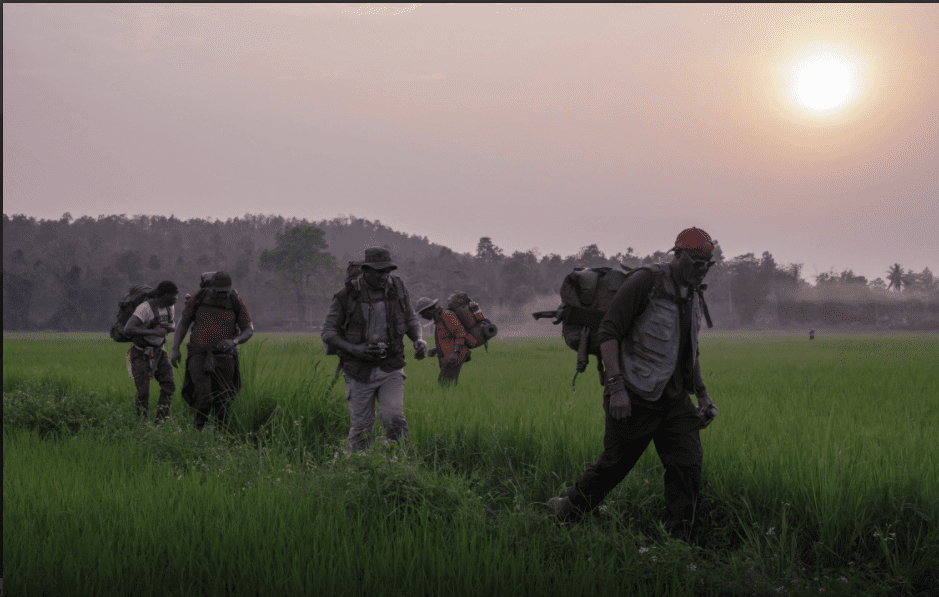
The world has perhaps never been more in need of a new Spike Lee joint. This one is called Da 5 Bloods, a Vietnam War picture now available on Netflix. It follows four vets who return to present day Vietnam to retrieve their former leader Norman’s (Chadwick Boseman) remains and bring them back to be buried in Arlington. However, as Paul (Delroy Lindo), Otis (Clarke Peters), Melvin (Isiah Whitlock Jr.) and Eddie (Norm Lewis) set off through the jungle, it becomes clear that there’s more to their journey than just honoring a fallen friend.
Though Lindo et al. play their characters in present day, they also play them in flashback. It’s perhaps a disorienting choice initially, but it also keeps the audience from having to work so hard to orient themselves in the flashback scenes, leaving more space to understand the character dynamics instead. Lee and cinematographer Newton Thomas Sigel also differentiate the timelines visually, first by giving them different aspect ratios (1:33 for the flashbacks and 2.39 for present day) and second through overall look, with the past resembling the grainier, more washed out ‘70s films stock and the present day looking fully saturated and crisp.
It’s smart filmmaking, however, quickly as the audience may accept Lee’s techniques for differentiating timelines, it’s also impossible to ignore how aimless the film’s first half feels. Everything from a surprise reveal from Otis’s old flame to the sudden appearance of Paul’s son, David (Jonathan Majors), is either brushed off for later or quickly resolved and it can be hard to tell what Lee and co-writers Danny Bilson, Paul De Meo and Kevin Willmott are trying to do or say for much of the film’s first half. The biggest issue, though, is just how clunky the writing feels. Every plot point or character beat feels like set up for what comes later, and the viewer’s attention is so frequently drawn to the story’s construction that it’s hard to invest in its stakes.
Perhaps the most egregious example is a trio of humanitarians played by Mélanie Thierry, Jasper Pääkkönen and Paul Walter Hauser. Thierry’s Hedy (yes, like Lamar) at first seems to exist only to flirt with David so he can tell us more about his relationship with his father and she can explain a bit of France’s colonial history in Vietnam. Pääkkönen‘s Seppo soon comes over to stake his claim on her and we naturally expect the scene to turn into a fight as it so often does on film. Instead, David must leave to carry a drunken Melvin to his room before Pääkkönen or Hauser get to say almost anything at all. The characters’ arcs feel unfinished and it’s almost painfully clear that this level of actors wouldn’t have been hired if they didn’t figure in whatever eventually happens in the jungle—especially given their characters’ profession.
That said, predictable as that return is, it’s also the film’s turning point and Da 5 Bloods not only improves greatly from then on but delivers on its extensive set up in very gratifying ways. It’s difficult to detail exactly how without spoiling much of the film’s plot, but a major factor is the slow shift to focusing on Paul’s arc. In the first half, Paul, with his MAGA hat and obvious PTSD, just seems like the group’s wild card, a fringe character who exists only to complicate things. However, as Paul’s past trauma begins to drive his and the film’s actions, Lindo becomes the de facto lead and he delivers a stunning performance.
In one of the film’s most compelling scenes, Paul monologues directly to the camera about his mortality, his feelings of betrayal by America, his trauma and even his relationship with David. It is impossible to tear your eyes away from Lindo in that moment and if there is an Oscar season this year, he should absolutely be a top contender. It’s masterful work, not just for the ways it deepens the character and makes the audience reevaluate his actions, it also succinctly and furiously lays out the points Lee’s film is trying to make about systemic racism in America.
The reason Da 5 Bloods’ characters sometimes feel too thin is because this is Lee–as he so often and so brilliantly does–using film tropes to explore larger, more complex ideas. In this case, it’s the long-term effects of systemic racism and colonialism—both American and otherwise. Sure, moments where he plays archival clips of Muhammad Ali talking about Vietnam or has Boseman’s character remind his fellow soldiers that a black man, Crispus Attucks, was the first man killed in the American Revolution are heavy-handed, but they’re also a reminder of how much black people have been written out of history. Similarly, when the soldiers are moved to violence after a communist radio personality named Hanoi Hannah (Van Veronica Ngo) reports that MLK has been killed and then asks why black American soldiers would keep fighting for a country that’s using them, the way Norman calms them down is a little corny, but there’s also undeniable power in his call for peace. Every element in Lee’s film is a direct challenge to viewers to interrogate America’s history and everything that happens is more potently symbolic because of that layered meaning.
Is Da 5 Bloods a great movie? That depends on a given viewer’s willingness to go wherever the film takes them. What Lee’s film is, though, is a profound and deeply satisfying act of catharsis. Though the characters function more as representations of ideas rather than fully-formed people, that big, metaphorical quality is precisely what allows Lee’s film to resonate so powerfully with our moment in history. Right now, every American is just one little drop in a wave of history in the making (from Black Lives Matter to COVID, to this very important election year) that will become a pivotal time in this country’s history. How incredible to get to see a film that can even come close to unpacking it.

